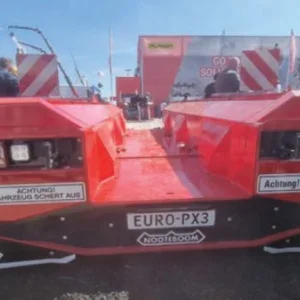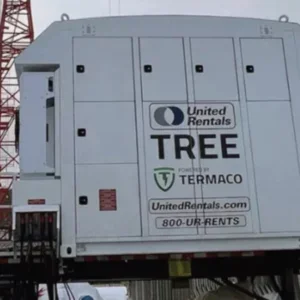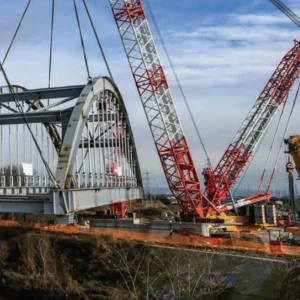Air suspension has been replacing traditional steel springs on commercial vehicles since about 1992. It gives a better ride that increases operator comfort, reduces travel time, and reduces vehicle wear and tear and therefore lowers maintenance costs and increases reliability. Greater load capacity is also possible. Most new trucks in North America and Western Europe are now fitted with it as standard and truck cranes are going the same way. First to adopt the system for truck cranes was Link-Belt in 1997, followed by Terex. And this year Grove has also started fitting it.
Air suspension can be used on existing designs and can often also be retrofitted to both single and twin axle sets. The first system to be fitted to cranes was on a tandem axle equalising beam, originally designed by Magnus Hendrickson in 1926. This design, known as a Hendrickson in the industry, is renowned for its durability and stability in heavy duty commercial and severe service vehicle applications. Poor ride quality, however, was a problem until air springing became available. To improve ride quality and reduce maintenance costs Canadian company Raydan Manufacturing, based in Alberta, developed air suspension technology for a heavy duty air spring conversion for the Hendrickson system to replace the traditional steel leaf spring packs. The Air Link was prototyped in 1986 and Raydan’s first air spring became available commercially in 1992. It was originally developed for the Northern logging industries in Canada and was introduced into the US market in 1995.
The first crane application for the Air Link walking beam suspension was on Link-Belt’s HC-238H and HC-248H hydraulic lattice boom truck cranes, rated at 150 US ton (136t) and 200 ton (182t) safe working load respectively. It is standard fitment on the tandem front axle of these cranes (solid rear) and also on the tandem rear axle of the 40 ton (36.3t) telescopic truck crane model HTC-8640, launched at Conexpo last year, and on the heavy lift version HTC-8640HL. Director of sales and marketing at Link-Belt, Bill Stramer, says: “The success to date with the air suspension on our truck cranes has been very good.” He does not rule out further applications for it by the company in the future.
Terex first fitted the Air Link to the rear tandem axle of its T200 (20 ton to 30 ton capacity) and T300 (30 ton to 40 ton capacity) telescopic truck cranes in 1998.
It is also standard fitment on the front tandem axle of the 50 ton T500, and, as an option (with about 50% takeup), on the rear tandem axle. The T 500 was launched at Conexpo 99 and production started about a year ago. Completing the range will be a 70 tonner, expected on the market by the middle of next year.
Grove’s first application for the Raydan suspension was the TMS 700E truck crane, prototyped earlier this year and in production since August. It is standard fitment on the front and rear tandem axles of this model which is available with either a 50 ton or 60 ton nominal rating. Next year air suspension should also be standard fitment on the 75 ton capacity TMS 875.
Raydan’s engineering vice president John Cook and sales and marketing manager Rick Nissen expect strong sales to the crane manufacturers this year, with between 300 and 400 units for Terex. Of this total Raydan expects about 200 of these to be for the T200 and T300 Terex truck crane series.
According to Cook and Nissen other suspension manufacturers still do not have an air suspension suitable for truck crane applications. Other systems lack the capacity, stability and/or amount of articulation needed, they claim. No other system can hold the load needed in crane applications, up to 63,000lb (29t) per tandem axle on air or 160,000lb (73t) off air, Cook says.
Road travel with air suspension is faster and smoother than conventional systems. For use on site, air pressure can be released from the Raydan system so that the crane runs on the bump stops, giving increased roll stability for pick and carry work. Other systems cannot run without air, according to Cook and Nissen, because the frame height drops. Air is restored to the Raydan system from the engine mounted compressor and is controlled by a switch.
Reduced driver fatigue, lower maintenance and increased vehicle reliability are due to less vibration and shock transmitted to the chassis and body from the road through the softer riding air suspension. Solid mount suspension offers little energy reduction capability which can result in damage such as cracked cross members, cracked booms and hydraulic failure.
Chassis and other structures can be lighter, thereby saving weight and increasing payload capacity. Air suspension systems weigh less than conventional steel spring types. Raydan claims a 200lb saving on a 40 ton capacity truck crane by replacing the 46,000lb Hendrickson spring pack with air suspension. Similarly, a 440lb (200kg) weight saving is achieved using air springs instead of the leaf spring pack on a Hendrickson RT2E-460 which is used on trucks.
Greater stability over competing air systems is also claimed for Raydan’s Air Link due to better vertical and roll stiffness. In truck applications this is borne out by third party testing conducted by the University of Michigan Transportation Research Institute in the USA. It analysed figures compiled by the National Research Council of Canada and found that the Air Link had up to twice the roll stiffness of competing air suspensions.
Nissen claims that there is additional roll resistance as a result of the dual height valves increasing the resistance on the more heavily loaded side of the suspension. Less axle hop is another benefit of the system, he says, and tyre life and braking can also be improved.






